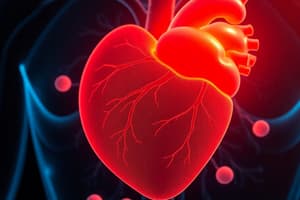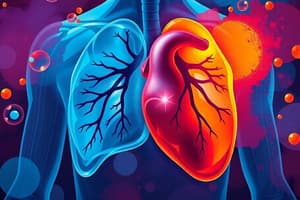Podcast
Questions and Answers
What is the primary mechanism of action of nitric oxide on vascular smooth muscle cells?
What is the primary mechanism of action of nitric oxide on vascular smooth muscle cells?
- Conversion of GTP to cGMP and leads to dephosphorylation of MLC (correct)
- Increase in the concentration of calcium ions
- Stimulation of the sympathetic nervous system
- Conversion of GTP to cGMP and leads to phosphorylation of MLC
Which of the following is a characteristic of isosorbide dinitrate when administered orally?
Which of the following is a characteristic of isosorbide dinitrate when administered orally?
- Rapid absorption and extensive first-pass metabolism (correct)
- No first-pass effect and high bioavailability
- Slow absorption and low bioavailability
- Rapid absorption and high bioavailability
What is the main effect of nitrates on veins?
What is the main effect of nitrates on veins?
- Constriction of veins and increase in venous return
- Dilation of veins and increase in venous capacitance (correct)
- Increase in venous tone and decrease in venous capacitance
- No significant effect on veins
Why are beta blockers often used in combination with nitrates in the treatment of angina?
Why are beta blockers often used in combination with nitrates in the treatment of angina?
What is the effect of nitrates on platelet aggregation?
What is the effect of nitrates on platelet aggregation?
What is the main advantage of sublingual administration of nitroglycerin?
What is the main advantage of sublingual administration of nitroglycerin?
What is the primary mechanism by which nitrates reduce oxygen demand in the heart?
What is the primary mechanism by which nitrates reduce oxygen demand in the heart?
Which of the following is a clinical application of nitrates?
Which of the following is a clinical application of nitrates?
What is the effect of nitrates on the arteriolar tone?
What is the effect of nitrates on the arteriolar tone?
What is the primary active metabolite of isosorbide dinitrate?
What is the primary active metabolite of isosorbide dinitrate?
Flashcards are hidden until you start studying
Study Notes
Classes of Drugs Used to Treat Angina
- Organic nitrates (NO donors)
- Beta adrenergic blocking agents
- Ca channel blockers
- All classes reduce O2 demand by decreasing heart rate, contractility, ventricular volume, and blood pressure
Organic Nitrates
- Nitrate/Nitrite: release NO in VSMC of target tissue, induce cross-tolerance
- Can be used in HF because patient has a high preload
- Examples: nitroglycerin (Nitrostat, NitroMist), isosorbide dinitrate (Isordil)
Pharmacokinetics of Organic Nitrates
- Large first-pass effect and low bioavailability
- Inactivated by hepatic organic nitrate reductase
- Short to very short half-life (except for IMSN – isosorbide mononitrate)
- High clearance rate; largely excreted by kidney
Chemical Structures and Metabolism of NG and ISDN
- NG (nitroglycerin) and ISDN (isosorbide dinitrate) metabolized into active metabolites with longer half-lives
- ISDN metabolized into isosorbide 2 mononitrate and isosorbide 5 mononitrate
Sublingual Route of NG
- Avoids first-pass effect
- Reaches therapeutic blood level in a few minutes
- Short duration of effect (10-30 minutes)
- Total dose administered limited
Mechanism of Action of Nitrates on VSMC
- Nitroglycerin converted to free radical nitrite ion by glutathione s-transferase
- NO is a potent dilator, primary target is GC
- Converts GTP to cGMP, leading to dephosphorylation of MLC and preventing interaction of actin and MLC
Direct Effects of Nitrates on VSM
- Potent dilators of veins (relax vein, increase venous capacitance, decrease venous return, and decrease ventricular volume/preload)
- Less sensitive on arteries (decrease arterial pressure, decrease afterload, and decrease wall stress)
Organic Nitrates Overall Effect
- Decrease in preload and afterload → decrease wall stress → decrease O2 demand
- Increase O2 supply by dilating large epicardial coronary arteries
Indirect (Harmful) Effects of Nitrates
- Decrease arterial pressure, activate baroreceptors, and lead to tachycardia and increased contractility
- Minimize reflex tachycardia: take beta blocker
Action of Nitrates on Platelets
- Nitrates converted into NO, activating GC in platelets, increasing cGMP, and decreasing platelet aggregation
Clinical Applications of Nitrates
- Chronic stable angina (imbalance of O2 demand and supply)
- Variant angina (Prinzimetal’s angina)
- Acute coronary syndrome (caused by plaque rupture)
Studying That Suits You
Use AI to generate personalized quizzes and flashcards to suit your learning preferences.



